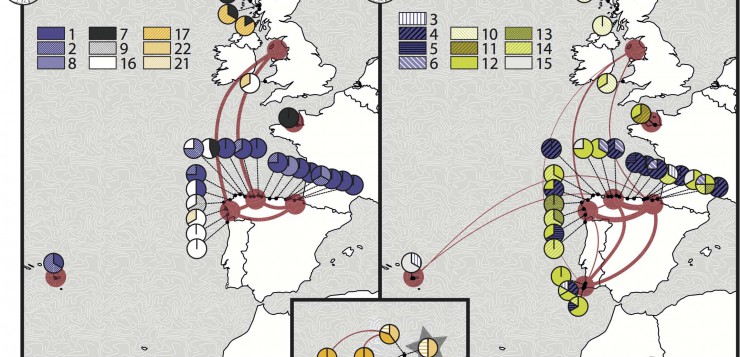Ortiz-Álvarez, Rüdiger, de los Ríos, Asunción, Fernández-Mendoza, F., Torralba-Burrial, Antonio, Pérez-Ortega, Sergio . PLoS ONE : DOI:10.1371/journal.pone.0132718 (2015) DIGITAL.CSIC
‘Tan cerca y tan lejos: descubierto un ejemplo de especialización ecológica en cianolíquenes marinos hermanos’
Un estudio en el litoral atlántico y cantábrico de las cianobacterias simbiontes de dos líquenes filogenéticamente hermanos, Lichina confinis y Lichina pygmaea, ha mostrado una clara separación ecológica entre los simbiontes de cada líquen, pertenecientes al género Rivularia. No obstante pese a su cercanía filogenética y espacial, dado que crecen a escasos metros de distancia en las franjas costeras supralitoral e intermareal, los simbiontes son exclusivos en cada franja y cada líquen.
Además un estudio geográfico ha mostrado una diferenciación de las poblaciones de simbiontes de Reino Unido, la existencia de un potencial ecotono en la cornisa cantábrica, y una separación total de las poblaciones de las Islas Canarias. La temperatura, la luz y el contenido de algunos nutrientes parecen claves en estas diferencias geográficas. Hasta la fecha, no se había realizado ningún estudio mediante técnicas moleculares de los simbiontes fotosintéticos en este grupo de líquenes (Lichinomycetes), por lo que los autores resaltan la novedad e importancia de continuar estudiando este linaje de cianolíquenes.
All fungi in the class Lichinomycetes are lichen-forming and exclusively associate with cyanobacteria. Two closely related maritime species of the genus Lichina (L. confinis and L. pygmaea) show similar distribution ranges in the Northeast Atlantic, commonly co-occurring at the same rocky shores but occupying different littoral zones. By means of 16S rRNA and phycocyanin operon markers we studied a) the phylogenetic relationships of cyanobionts associated with these species, b) the match of divergence times between both symbionts, and c) whether Lichina species differ in photobiont association and in how geography and ecology affect selectivity. The cyanobionts studied are closely related to both marine and freshwater strains of the genus Rivularia.We found evidence of a high specificity to particular cyanobiont lineages in both species: Lichina pygmaea and L. confinis incorporate specific lineages of Rivularia that do not overlap at the haplotype nor the OTU levels. Dating divergences of the fungal and cyanobacterial partners revealed an asynchronous origin of both lineages. Within each fungal species, selectivity varied across the studied area, influenced by environmental conditions (both atmospheric and marine), although patterns were highly correlated between both lichen taxa. Ecological speciation due to the differential association of photobionts to each littoral zone is suspected to have occurred in marine Lichina.


